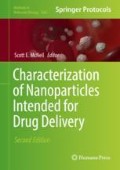Abstract
Novel nanoformulated chemotherapeutics and diagnostics require demonstration of efficacy and safety in appropriate animal models prior to conducting early-phase clinical trials. In vivo efficacy experiments are tailored to the tumor model type and route of administration as well as several parameters related to the nanoformulation, like drug loading to determine dosing volume. When designing in vivo efficacy studies for nanomedicines, understanding the relationship between tumor biology and the nanoformulation characteristics is critical to achieving meaningful results, along with applying appropriate drug and nanoformulation controls. In particular, nanoparticles can have multifunctional roles such as targeting and imaging capabilities that require additional considerations when designing in vivo efficacy studies and choosing tumor models. In this chapter, we outline a general study design for a subcutaneously implanted tumor model along with an example of tumor growth inhibition and survival analysis.
Access this chapter
Tax calculation will be finalised at checkout
Purchases are for personal use only
References
Sparreboom A, Scripture CD, Trieu V, Williams PJ, De T, Yang A, Beals B, Figg WD, Hawkins M, Desai N (2005) Comparative preclinical and clinical pharmacokinetics of a cremophor-free, nanoparticle albumin-bound paclitaxel (ABI-007) and paclitaxel formulated in Cremophor (Taxol). Clin Cancer Res 11(11):4136–4143. doi:10.1158/1078-0432.ccr-04-2291
Desai NP, Trieu V, Hwang LY, Wu R, Soon-Shiong P, Gradishar WJ (2008) Improved effectiveness of nanoparticle albumin-bound (nab) paclitaxel versus polysorbate-based docetaxel in multiple xenografts as a function of HER2 and SPARC status. Anticancer Drugs 19(9):899–909. doi:10.1097/CAD.0b013e32830f9046
Maeda H (2015) Toward a full understanding of the EPR effect in primary and metastatic tumors as well as issues related to its heterogeneity. Adv Drug Deliv Rev 91:3–6. doi:10.1016/j.addr.2015.01.002
Hobbs SK, Monsky WL, Yuan F, Roberts WG, Griffith L, Torchilin VP, Jain RK (1998) Regulation of transport pathways in tumor vessels: role of tumor type and microenvironment. Proc Natl Acad Sci U S A 95(8):4607–4612
Monsky WL, Fukumura D, Gohongi T, Ancukiewcz M, Weich HA, Torchilin VP, Yuan F, Jain RK (1999) Augmentation of transvascular transport of macromolecules and nanoparticles in tumors using vascular endothelial growth factor. Cancer Res 59(16):4129–4135
Adiseshaiah PP, Hall JB, McNeil SE (2010) Nanomaterial standards for efficacy and toxicity assessment. Wiley Interdiscip Rev Nanomed Nanobiotechnol 2(1):99–112. doi:10.1002/wnan.66
Cai W, Chen K, Mohamedali KA, Cao Q, Gambhir SS, Rosenblum MG, Chen X (2006) PET of vascular endothelial growth factor receptor expression. J Nucl Med 47(12):2048–2056
Heldin C-H, Rubin K, Pietras K, Ostman A (2004) High interstitial fluid pressure [mdash] an obstacle in cancer therapy. Nat Rev Cancer 4(10):806–813
Diop-Frimpong B, Chauhan VP, Krane S, Boucher Y, Jain RK (2011) Losartan inhibits collagen I synthesis and improves the distribution and efficacy of nanotherapeutics in tumors. Proc Natl Acad Sci 108(7):2909–2914. doi:10.1073/pnas.1018892108
Folarin AA, Konerding MA, Timonen J, Nagl S, Pedley RB (2010) Three-dimensional analysis of tumour vascular corrosion casts using steroimaging and micro-computed tomography. Microvasc Res 80(1):89–98. doi:10.1016/j.mvr.2010.03.007
Yuan F, Dellian M, Fukumura D, Leunig M, Berk DA, Torchilin VP, Jain RK (1995) Vascular permeability in a human tumor xenograft: molecular size dependence and cutoff size. Cancer Res 55(17):3752–3756
Diehl K-H, Hull R, Morton D, Pfister R, Rabemampianina Y, Smith D, Vidal J-M, Vorstenbosch CVD (2001) A good practice guide to the administration of substances and removal of blood, including routes and volumes. J Appl Toxicol 21(1):15–23. doi:10.1002/jat.727
Shah H (2011) How to calculate sample size for animal studies? Natl J Physiol Pharm Pharmacol 1(1):35–39
Acknowledgment
Frederick National Laboratory is accredited by AAALAC International and follows the Public Health Service Policy for the Care and Use of Laboratory Animals (Health Research Extension Act of 1985, Public Law 99-158, 1986). Animal care is provided in accordance with the procedures outlined in the “Guide for Care and Use of Laboratory Animals” (National Research Council, 1996; National Academy Press, Washington, D.C.). All animal protocols are approved by the FNL Institutional Animal Care and Use Committee (IACUC). Any experiments performed are scientifically justified and are not an unnecessary duplication of previous work by others.
This project has been funded in whole or in part with Federal funds from the National Cancer Institute, National Institutes of Health, under Contract No. HHSN261200800001E. The content of this publication does not necessarily reflect the views or policies of the Department of Health and Human Services, nor does mention of trade names, commercial products, or organizations imply endorsement by the U.S. Government.
Author information
Authors and Affiliations
Corresponding author
Editor information
Editors and Affiliations
Rights and permissions
Copyright information
© 2018 Springer Science+Business Media LLC
About this protocol
Cite this protocol
Adiseshaiah, P.P., Stern, S.T. (2018). Designing an In Vivo Efficacy Study of Nanomedicines for Preclinical Tumor Growth Inhibition. In: McNeil, S. (eds) Characterization of Nanoparticles Intended for Drug Delivery. Methods in Molecular Biology, vol 1682. Humana Press, New York, NY. https://doi.org/10.1007/978-1-4939-7352-1_20
Download citation
DOI: https://doi.org/10.1007/978-1-4939-7352-1_20
Published:
Publisher Name: Humana Press, New York, NY
Print ISBN: 978-1-4939-7350-7
Online ISBN: 978-1-4939-7352-1
eBook Packages: Springer Protocols

